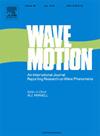The effect of 3D surface roughness on acoustic wave propagation in a cylindrical waveguide
Abstract
This paper studies the acoustic wave scattering and attenuation in a cylindrical waveguide (pipe) with wall roughness varying along all three dimensions and roughness height smaller than the acoustic wavelength. Using the decomposition of the acoustic wave field into deterministic and random components, small perturbation method and Fourier transform the analytical solution of a 3-D averaged acoustic wave field is obtained. The correction term describing the mechanism of wave attenuation caused by roughness and determined by the modal cross-talk is also derived. The solution for the plane wave is validated in the frequency range extended well beyond the second cut-off frequency, where the crosstalk between the fundamental and non-axisymmetric modes are observed. The analytical solution is compared with the numerical results obtained with the Monte-Carlo method and Finite Element solver. The numerical study results have demonstrated a close agreement with the analytical solution for the averaged sound field, dispersion curves, and the wave attenuation effect expressed as the wavenumber correction term. A key novelty of this work is a comprehensive analysis of wave dispersion and cut-off frequency changes due to the presence of 3-D wall roughness in a pipe.

 求助内容:
求助内容: 应助结果提醒方式:
应助结果提醒方式:


